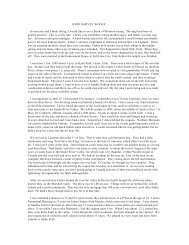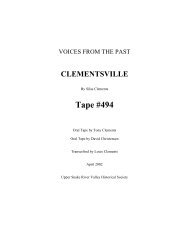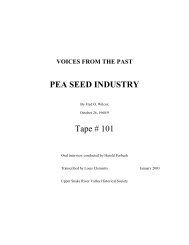HelPeR - BYU Idaho Special Collections and Family History
HelPeR - BYU Idaho Special Collections and Family History
HelPeR - BYU Idaho Special Collections and Family History
You also want an ePaper? Increase the reach of your titles
YUMPU automatically turns print PDFs into web optimized ePapers that Google loves.
O i a K a r me m c e oo<br />
a a z e a we e o b e s e<br />
p n m d<br />
y d<br />
filmmakers <strong>and</strong> television shows, such as Sex in the<br />
City <strong>and</strong> Malcolm in the Middle, but the film type had<br />
many detractions for the non-professional user.<br />
16mm cameras were bulky, heavy, expensive,<br />
<strong>and</strong> frequently required a tripod for usable footage.<br />
Kodak realized that a simple film <strong>and</strong> camera<br />
would alleviate many of the technical aspects of<br />
16mm production. As a result, the company developed<br />
the 8mm by splitting a st<strong>and</strong>ard 16mm film in<br />
half. They then introduced the boxy art deco Kodak<br />
Cine clockwork camera.<br />
8mm, now known as straight 8 or regular 8, debuted<br />
in 1935 <strong>and</strong> ushered in the epoch of the home motion<br />
picture by drastically reducing the size of the camera<br />
into a truly h<strong>and</strong> held object. Kodak slashed user costs<br />
because the new smaller format required 75% percent<br />
less film than 16mm. The company continued its innovations<br />
<strong>and</strong> in 1936 introduced Kodachrome stock,<br />
which allowed color motion photography. For nearty<br />
30 years regular 8 dominated the scene, until its reign<br />
A d g e p re m 9<br />
A q l y e<br />
was shattered in 1965 by the introduction of Super 8,<br />
a beefed up derivative of the straight 8.<br />
Super 8 reduced the size of the 8mm sprocket holes<br />
cutting user film costs by maximizing the usable size<br />
of the film. The new format was incredibly popular.<br />
Over 100,000 cameras were sold to U.S. servicemen<br />
in Vietnam alone. These, new, spiffy high-tech cameras<br />
incorporated many features like light meters <strong>and</strong><br />
magnetic sound printing. To facilitate easy loading,<br />
a new quick-load plastic magazine was also introduced,<br />
but film’s days were numbered.<br />
Despite the great developmental strides made by<br />
Super 8, film remained a complicated medium. Exposures,<br />
apertures, <strong>and</strong> editing were difficult matters<br />
that befuddled the average user. The introduction<br />
of video camcorders in the 1980s addressed these<br />
problems by greatly simplifying photography, but<br />
there were many unforeseen pitfalls.<br />
The great advantage film has over videotapes,<br />
whether it is 16mm, 8mm, or Super 8, is archival<br />
Ja n ua ry/Fe b r u a r y 2009 Ev e r t o n’s Ge n e a l o g i c a l He l p e r © 25














